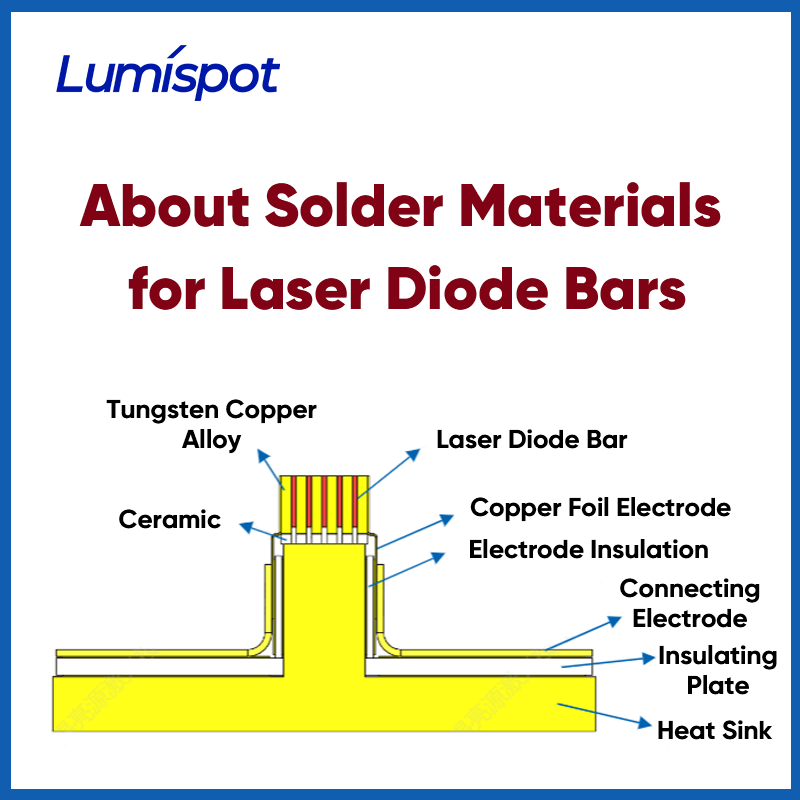In the design and manufacturing of high-power semiconductor lasers, laser diode bars serve as the core light-emitting units. Their performance depends not only on the intrinsic quality of the laser chips but also heavily on the packaging process. Among the various components involved in packaging, solder materials play a vital role as the thermal and electrical interface between the chip and the heat sink.

1. The Role of Solder in Laser Diode Bars
Laser diode bars typically integrate multiple emitters, resulting in high power densities and stringent thermal management requirements. To achieve efficient heat dissipation and structural stability, solder materials must meet the following criteria:
① High thermal conductivity:
Ensures efficient heat transfer from the laser chip.
② Good wettability:
Provides tight bonding between the chip and the substrate.
③ Appropriate melting point:
Prevents reflow or degradation during subsequent processing or operation.
④ Compatible coefficient of thermal expansion (CTE):
Minimizes thermal stress on the chip.
⑤ Excellent fatigue resistance:
Prolongs the service life of the device.
2. Common Types of Solder for Laser Bar Packaging
The following are the three main types of solder materials commonly used in the packaging of laser diode bars:
① Gold-Tin Alloy (AuSn)
Properties:
Eutectic composition of 80Au/20Sn with a melting point of 280°C; high thermal conductivity and mechanical strength.
Advantages:
Excellent high-temperature stability, long thermal fatigue life, free of organic contamination, high reliability
Applications:
Military, aerospace, and high-end industrial laser systems.
② Pure Indium (In)
Properties:
Melting point of 157°C; soft and highly malleable.
Advantages:
Superior thermal cycling performance, low stress on the chip, ideal for protecting fragile structures, suitable for low-temperature bonding requirements
Limitations:
Prone to oxidation; requires inert atmosphere during processing, lower mechanical strength; not ideal for high-load applications
③ Composite Solder Systems (e.g., AuSn + In)
Structure:
Typically, AuSn is used beneath the chip for robust attachment, while In is applied on top for enhanced thermal buffering.
Advantages:
Combines high reliability with stress relief, improves overall packaging durability, adapts well to diverse operating environments
3. Impact of Solder Quality on Device Performance
Solder material selection and process control significantly affect the electro-optical performance and long-term stability of laser devices:
Solder Factor | Impact on Device |
Solder layer uniformity | Affects heat distribution and optical power consistency |
Void ratio | Higher voids lead to increased thermal resistance and localized overheating |
Alloy purity | Influences melting stability and intermetallic diffusion |
Interfacial wettability | Determines bonding strength and interface thermal conductivity |
Under high-power continuous operation, even minor defects in soldering can lead to thermal buildup, resulting in performance degradation or device failure. Therefore, selecting high-quality solder and implementing precise soldering processes are fundamental to achieving high-reliability laser packaging.
4. Future Trends and Development
As laser technologies continue to penetrate into industrial processing, medical surgery, LiDAR, and other fields, solder materials for laser packaging are evolving in the following directions:
① Low-temperature soldering:
For integration with thermally sensitive materials
② Lead-free solder:
To meet RoHS and other environmental regulations
③ High-performance thermal interface materials (TIM):
To further reduce thermal resistance
④ Micro-soldering technologies:
To support miniaturization and high-density integration
5. Conclusion
Though small in volume, solder materials are the critical connectors that ensure the performance and reliability of high-power laser devices. In the packaging of laser diode bars, selecting the right solder and optimizing the bonding process are essential to achieving long-term stable operation.
6. About Us
Lumispot is committed to providing customers with professional and reliable Laser Components and packaging solutions. With extensive experience in solder material selection, thermal management design, and reliability evaluation, we believe that every refinement in detail paves the way to excellence. For more information on high-power laser packaging technology, feel free to contact us.
Contact: Lumispot
Phone: +86-15072320922
Tel: +86-510-87381808
Email: sales@lumispot.cn
Add: Bldg 4 No.99 Fu Rong 3rd Road, Wuxi, China